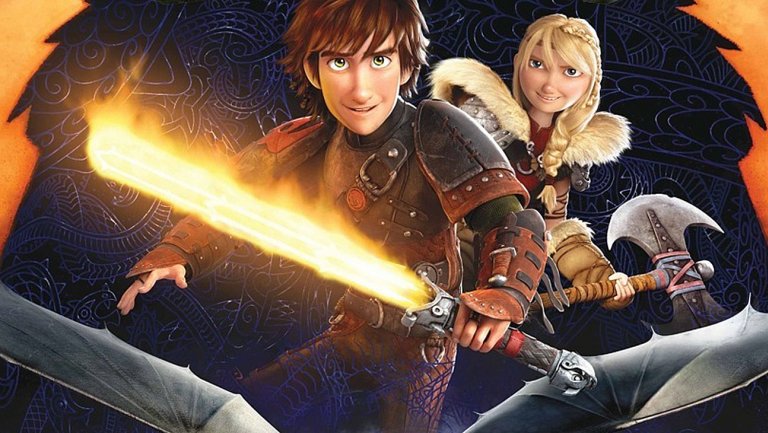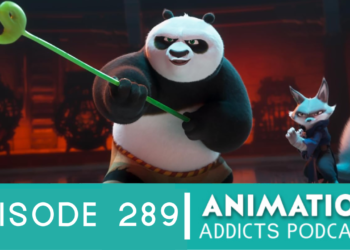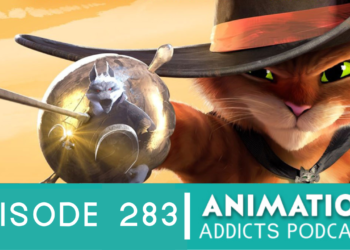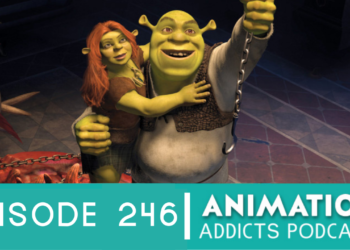The How to Train Your Dragon saga will expand to a new format next spring with How to Train Your Dragon: The Serpent’s Heir, the first in a series of graphic novels from Dark Horse Comics that picks up the story of Hiccup and Toothless after the conclusion of How to Train Your Dragon 2 in addition to delving deeper into the characters and the larger mythology of the Dragons franchise.
Through several weeks of careful maneuvering and a lot of patience, I was finally able to speak with none other than the writers of the graphic novels themselves: How to Train Your Dragon writer/director Dean DeBlois and Race to the Edge writer Richard Hamilton!
In this interview, we talk about the inspiration behind the creation of the graphic novels, the process of writing a graphic novel, the benefits of telling a story within the comic format, exactly how many books are planned in the series, and how the graphic novels will connect with the feature films and the TV show.
(A HUGE thank you to our contacts at DreamWorks Animation for setting this up!)
Brandon Smith: First off, let me begin by saying that it is such a joy getting to speak to both of you. Let’s start simply by talking about the inspiration behind the graphic novels. Specifically, what was the motivation behind taking the How to Train Your Dragon franchise into the comic format?
Richard Hamilton: It’s our pleasure! I would say there were two main motivations at work. The first was that, thanks to Dean’s work in the films and the TV team’s excellent shows and Cressida Cowell’s original book series, How to Train Your Dragon is an incredibly fertile saga for exploration and expansion. Comics just seemed like the perfect medium to chart these new adventures that not only world-build, but also take us deeper emotionally with our characters, both human and dragon. And the second, more personal motivation is that Dean and I both grew up on — and learned storytelling from — comic books. So, for us, these graphic novels are the blending of two of our passions.
BS: Beginning with the first film back in 2010, How to Train Your Dragon has not only grown to become one of DreamWorks Animation’s most beloved properties, but it has also become an iconic animated franchise in general and one that’s well known for being a little more epic and mature than what is typically seen in western animation. In your view, what makes How to Train Your Dragon the perfect fit for the graphic novel medium?
Dean DeBlois: It’s an exciting expansion for the Riders of Berk following the second film. When we’re confined to 90 minutes of a film, we don’t have the luxury of always digging into all backstories or giving more time to supporting characters. The graphic novel format allows for a little more flexibility there. For instance, we know Valka was gone for over 20 years so we can take some time to answer the questions of what she was up to all that time. We can even dive into more of the characters’ inner thoughts as we move through the new stories.
BS: This question is for Richard. As one of the writers of DreamWorks Dragons: Race to the Edge, you already have the fortune of being well acquainted with the Dragons mythology. In addition, you also have the experience of having written for a serialized medium (specifically TV animation). What are the strengths and advantages you feel you can bring to the graphic novels?
RH: Yes, I’ve been lucky enough to write for the Dragons franchise in one form or another for over seven years, so I definitely feel a bit of a sense of authority and responsibility over all of that lore. And I have also written, edited, and published my own comics in the past, so I’m keenly aware of the challenges and opportunities of sequential storytelling and I’m writing specifically to that medium.
But honestly, I’ve been fantasizing about working on How to Train Your Dragon comics for years so, more than anything, I hope that enthusiasm is evident on the page. I truly know and love these characters (even Snotlout) as a DreamWorker, as a fan, and now, through my sons, as a dad.
BS: This project is unique in that both of you come from the world of animation, but – as both of you pointed out at Dark Horse Comics’ announcement panel at this year’s New York Comic Con – you both share a love for comics. In you own view, what do you feel are the differences and similarities of writing for animation (be it TV or film) versus writing a graphic novel?
RH: For me, comics are like this extreme — and very rewarding — distillation of the best attributes of animation. Since both are visual mediums, you have to think in terms of images, not just words. And it’s helpful to be economical in your storytelling in comics and animation, since you always have to be mindful of budgets and runtimes in animation and not cluttering the art on a comics page with lots of word balloons.
Beyond that, animation has the advantage of a musical score to help convey emotion and tone, while comics obviously do not. On the flip side, though, comics really allow you to shape the audience’s experience of the story in an active way by going from a bunch of sequential panels to a giant two-page spread, for example. That would be like changing the size and dimensions of the screen in the middle of a film or TV episode.
DD: There are a lot of compromises you often have to make in animation because it is very expensive. I have had a lot of ideas for the films that have had to be rethought, contained and presented in a less ambitious way simply due to budget. Comics completely remove those limitations and we can build the scenes and story with complete disregard to what it would actually cost to produce in animation. For instance, without spoiling too much, we can finally have an epic underwater adventure that is just too difficult to do in animation. It’s very freeing.
BS: Dark Horse Comics is primarily known for titles like Hellboy, Sin City, The Goon, Conan the Barbarian, and countless others. At the same time, it also served as the home for younger-skewing properties like Usagi Yojimbo, Groo, Nickelodeon’s Avatar titles, and the popular works of frequent collaborators Art Baltazar and Franco Aureliani (Itty Bitty Comics and Aw Yeah Comics!). What makes Dark Horse Comics the perfect home for a property like How to Train Your Dragon?
DD: Dark Horse has been incredibly successful with other licensed properties. But they don’t simply retell those same stories. Working closely with them we’ve been able to find the perfect balance that retains the same sense of adventure and wonder of the films, but also adds to the overall world of How to Train Your Dragon with brand new adventures, characters, and dragons.
BS: Let’s go off topic for a little bit with a question for Dean. There is almost always an ongoing argument within the Dragons fandom over what can be considered canon or not if it’s in any other medium outside the feature films and shorts. Even the TV series has its ‘canon’ status called into question on a regular basis. In your own opinion, what do you consider to be the official canon for the How to Train Your Dragon franchise?
DD: The feature film trilogy and the characters contained within it serve a narrative purpose specific to those three films, but we’ve made efforts to ensure that every expansion, whether it’s in the TV series, comics, or other mediums, have a sense of tonal consistency and storytelling unity in keeping with the feature films. The only real exception is Cressida Cowell’s book series, being that her storyline focuses on a younger Hiccup and his talking, dog-sized dragon named Toothless. The feature films were a conscious departure from Cressida’s books, in order to tell a story that had more of the tropes of a fantasy adventure. So, within the world of the films, we have tried to remain consistent in all of the expansions. The comic books will adhere to the same constraints and tone of the trilogy. The TV series and comics are meant to fill in time jumps between the films, offering insight and back-story to compliment the main narrative of Hiccup’s coming-of-age.
BS: How do you two approach the process of co-writing a graphic novel? Do you take turns writing a specific number of pages, or are you tasked with handling a specific number of chapters at a time (assuming that’s how the books will be structured)?
RH: I was fortunate enough to serve as Dean’s assistant and script coordinator on HTTYD 2, so I like to think I’m already very familiar with not only the stories he likes to tell, but also how Dean likes to tell them. Because of that familiarity, our process is usually pretty free-form. We typically meet in person to break the story for each graphic novel, and then I’ll concretize that into an outline. I’ll write a first pass of the script, usually emailing Dean a bunch of questions along the way. Dean then goes through the script and tweaks any of the dialogue, panel descriptions or language. As in animation, it’s an iterative — and fun — process that benefits from the involvement of many talented people.
As far as the structure goes, we aren’t really employing discrete chapters in the graphic novels, but we do try to conform to the three act structure in each one. We’re also building in larger plot and character elements that connect the books to each other and the second and third films in a subtle way. Each book stands on its own but, if you’re a fan of the series, you’ll definitely pick up on a larger narrative.
BS: Do either of you have a solid idea of how many books you want to do in this particular series? Are there any other stories in the Dragons universe that you would like to tell in this format?
RH: The initial plan includes three graphic novels, but we expect it to grow from there!
BS: This question can be answered by either of you (continuing off of question #6 for a bit). Are there any elements from the TV show (characters, plotlines, settings, etc.) that will carry over or be touched upon in the graphic novels? Similarly, are there any elements from Cressida Cowell’s original books that you want to incorporate into the graphic novels?
RH: The answer to both is a resounding “Yes!” Part of the fun of the comics is coming up with new human and dragon characters and worlds, and part of it is mixing and matching elements from across the franchise to create new stories. How would Eret and Heather react to each other if they met? Is there a heist story to be told in the comics where the alarm system is made up of a bunch of tiny dragons?
But we have to be a little careful with the continuity, as the TV show takes place before the event of the second movie, and our graphic novels come after, so we don’t want to spoil any of their awesome stories. Cressida Cowell’s series is a bit more removed from that continuity, so I think the challenge there is for us to reinterpret some of her ideas in a way that works for comics, which is a pretty tall order, since her books are just so great.
BS: This last question is for Dean. How to Train Your Dragon 3 arrives in theaters in 2018, but these graphic novels will be the first official account of what happens to Hiccup, Toothless, and the rest of the dragon riders in the immediate aftermath of How to Train Your Dragon 2. While I understand the third film is still in early development, can we expect any hints or clues as to what may might happen in How to Train Your Dragon 3? More importantly, will anything in the graphic novels inform the events in How to Train Your Dragon 3 in any significant way?
DD: I don’t want to give too much away this early but readers should expect a few “dragon eggs.”
How to Train Your Dragon: The Serpent’s Heir arrives in bookstores and comic shops on April 26, 2016. The first 13 episodes of DreamWorks Dragons: Race to the Edge are now available to stream on Netflix. How to Train Your Dragon 3 arrives in theaters on June 28, 2018.
What are your thoughts on this interview? What else would you like to know about the How to Train Your Dragon graphic novels?
Edited by: Hannah Wilkes





![[REVIEW]: ‘The Bad Guys’ – So Bad, It’s Good](https://www.rotoscopers.com/wp-content/uploads/2022/04/MV5BZDA0MmJiZDktMjVjNy00NDA1LTg5MzMtZTVmY2Y4MTE0OTVjXkEyXkFqcGdeQWFybm8@._V1_-350x250.jpg)
